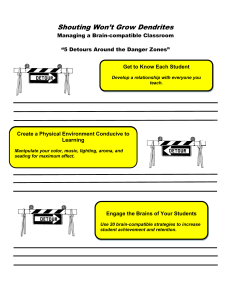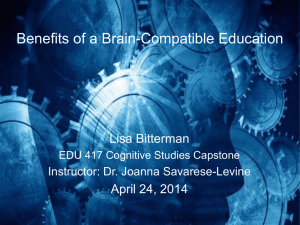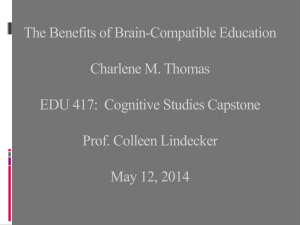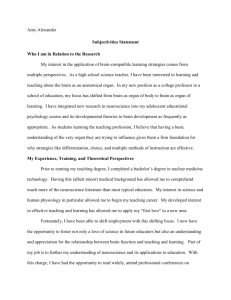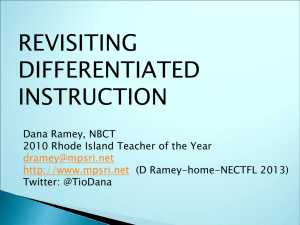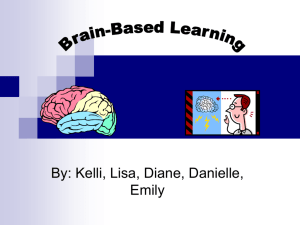Teaching with the Brain in Mind
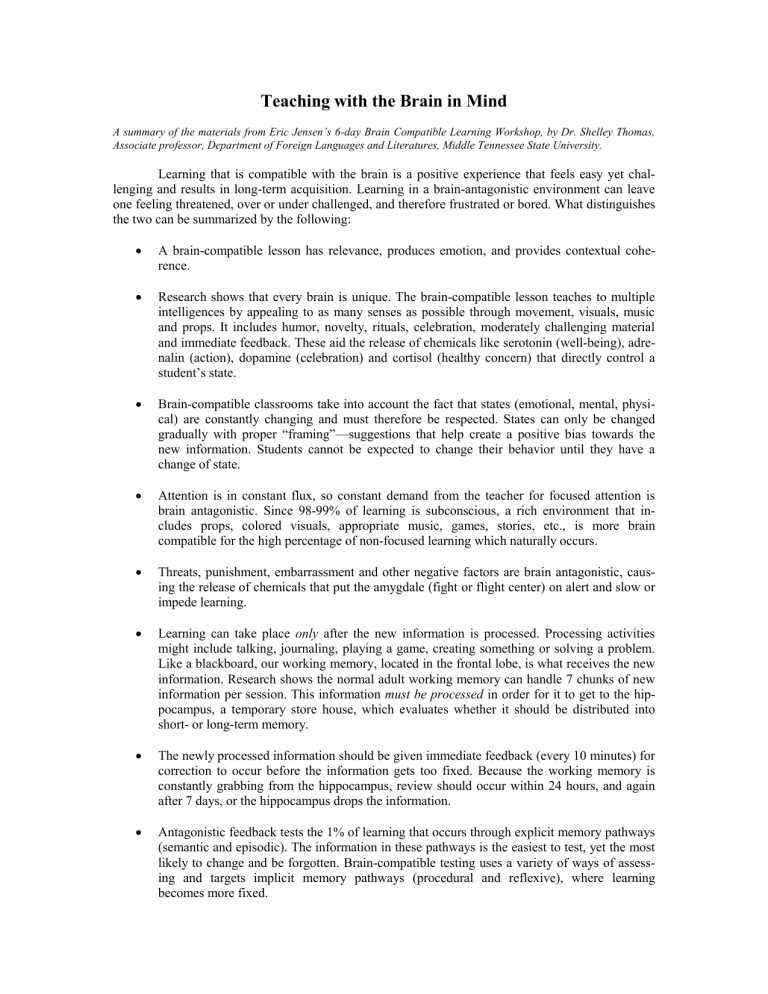
Teaching with the Brain in Mind
A summary of the materials from Eric Jensen’s 6-day Brain Compatible Learning Workshop, by Dr. Shelley Thomas,
Associate professor, Department of Foreign Languages and Literatures, Middle Tennessee State University.
Learning that is compatible with the brain is a positive experience that feels easy yet challenging and results in long-term acquisition. Learning in a brain-antagonistic environment can leave one feeling threatened, over or under challenged, and therefore frustrated or bored. What distinguishes the two can be summarized by the following:
A brain-compatible lesson has relevance, produces emotion, and provides contextual coherence.
Research shows that every brain is unique. The brain-compatible lesson teaches to multiple intelligences by appealing to as many senses as possible through movement, visuals, music and props. It includes humor, novelty, rituals, celebration, moderately challenging material and immediate feedback. These aid the release of chemicals like serotonin (well-being), adrenalin (action), dopamine (celebration) and cortisol (healthy concern) that directly control a student’s state.
Brain-compatible classrooms take into account the fact that states (emotional, mental, physical) are constantly changing and must therefore be respected. States can only be changed gradually with proper “framing”—suggestions that help create a positive bias towards the new information. Students cannot be expected to change their behavior until they have a change of state.
Attention is in constant flux, so constant demand from the teacher for focused attention is brain antagonistic. Since 98-99% of learning is subconscious, a rich environment that includes props, colored visuals, appropriate music, games, stories, etc., is more brain compatible for the high percentage of non-focused learning which naturally occurs.
Threats, punishment, embarrassment and other negative factors are brain antagonistic, causing the release of chemicals that put the amygdale (fight or flight center) on alert and slow or impede learning.
Learning can take place only after the new information is processed. Processing activities might include talking, journaling, playing a game, creating something or solving a problem.
Like a blackboard, our working memory, located in the frontal lobe, is what receives the new information. Research shows the normal adult working memory can handle 7 chunks of new information per session. This information must be processed in order for it to get to the hippocampus, a temporary store house, which evaluates whether it should be distributed into short- or long-term memory.
The newly processed information should be given immediate feedback (every 10 minutes) for correction to occur before the information gets too fixed. Because the working memory is constantly grabbing from the hippocampus, review should occur within 24 hours, and again after 7 days, or the hippocampus drops the information.
Antagonistic feedback tests the 1% of learning that occurs through explicit memory pathways
(semantic and episodic). The information in these pathways is the easiest to test, yet the most likely to change and be forgotten. Brain-compatible testing uses a variety of ways of assessing and targets implicit memory pathways (procedural and reflexive), where learning becomes more fixed.
Research shows that the brain becomes smarter (grows new dendrites) through trial and error because it enables the student to learn from experience how to eliminate poor choices. The brain-compatible teacher realizes the student rarely gets the right answer the first time after being exposed to new information and that non-threatening activities like games and pair work provide a safe environment where the important stage of mistake-making can occur.
“Current brain research validates the use of total physical response [TPR] in several ways.
First, a significant pathway for memory retrieval is through the physical body. This is known as procedural memory. We often recall what something is or what we wanted to do by simply getting up and moving. Second, areas in the brain that activate movement (cerebellum, frontal lobes, basal ganglia, motor cortex, etc.) are also well connected to the pleasure centers in the brain. Motion activates emotion; hence, moving can engage positive feelings and better retrieval. And finally, the peptide molecules which store information are distributed throughout the body. This means that almost any movement or motion can activate feelings and memories.”
Excerpt from Joful Fluency: Brain-Compatible Second Language Acquisition , co-authored by Eric Jensen, published in 1998, page 27.
